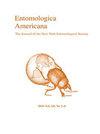拉多纳(Say)最后一种体育场若虫的描述(蜥足目:蜥足科)
IF 0.3
4区 农林科学
Q4 ENTOMOLOGY
引用次数: 2
摘要
拉多纳·埃苏斯塔(Say)是一种小型的libelluline蜻蜓,分布于从纽芬兰南部到弗吉尼亚州的北美大西洋沿岸地区。根据在马萨诸塞州,新泽西州和纽约州的浅池塘中收集的20只若虫,我们描述了该属中最后一种未知的若虫。触须有5个主要的刚毛,不同于其更广泛的同类,L. deplanata和L. julia,它们通常每侧有6个,有时有7个(很少有5或8个)。几乎所有的L. exusta若虫都可以通过触须的数量(5 vs .6)和外稃长度与后掌长度的比值(0.42-0.48 vs . 0.49-0.67)与L. deplanata分开。毛蕊草在许多性状上都小于李草,其中最显著的是前叶长度(3.70 ~ 3.90 mm)和最大宽度(3.35 ~ 3.85 mm)。本文章由计算机程序翻译,如有差异,请以英文原文为准。
Description of the last stadium nymph of Ladona exusta (Say) (Odonata: Libellulidae)
Abstract Ladona exusta (Say) is a small libelluline dragonfly restricted to the Atlantic coastal region of North America from southern Newfoundland to Virginia. Based on 20 nymphs collected in shallow ponds in Massachusetts, New Jersey and New York, we describe the final unknown nymph of the genus. The palps have 5 major setae, differing from its more widespread congeners, L. deplanata and L. julia, which normally have 6 on each side, sometimes 7 (rarely 5 or 8). Nearly all L. exusta nymphs can be separated from L. deplanata using the number of palpal setae (5 v. 6) in conjunction with the ratio of epiproct length to metafemur length (0.42–0.48 v. 0.49–0.67). Ladona exusta is smaller than L. julia in a number of characters, the most distinctive of which are prementum length (3.70–3.90 mm vs. 3.90–4.75 mm) and prementum maximum width (3.35–3.85 mm vs. 3.90–4.85 mm).
求助全文
通过发布文献求助,成功后即可免费获取论文全文。
去求助
来源期刊

Entomologica Americana
ENTOMOLOGY-
CiteScore
0.30
自引率
0.00%
发文量
0
审稿时长
>12 weeks
期刊介绍:
Entomologica Americana, the journal of The New York Entomological Society, publishes original research on the taxonomy, classification, phylogeny, biogeography, behavior and natural history of insects and other arthropod taxa. Manuscripts are published as research articles, shorter scientific notes or book reviews.
 求助内容:
求助内容: 应助结果提醒方式:
应助结果提醒方式:


